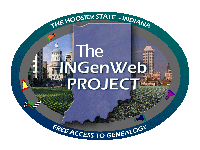History of Yeddo
Source: "Obituaries - Year - 1960 Volume B" from the Covington Public Library. Year 1964
By Hazel Purnell Myers
When I moved to Yeddo, in 1893, it was a thriving village. Many and profitable industries were located in the village and adjoining areas.
When the town was first settled (many years before my time) there was no railroad. Obviously the mines and the grain farmers demanded a means of outlet for their produce. In 1880 the railroad was started and was known as Indiana Black Coal Road. The first train ran in March 1881, just between Veedersburg and Yeddo. In 1883 the road was purchased by C&EI and run to Brazil and then to Fair Oaks, Indiana. Some of the railroad Agents were: Dick Myers, Jimmy Means, Ed Small and Fred Beals.
The first store building was built by a Mr. Bonebrake. The building was later occupied by G. F. Sines.
Perhaps the largest source of growth was from the coal mines. In 1883 land was leased for the first mine by A. J. Dall. Two mines that I recall were the "Hutts" mine east of town, and the 'Duchane" mine north and west. There were many others.
Being in an agriculture area, an elevator was essential. Some of the elevator men were: Ed Small, Tom Glascock, Farris Starnes, and Charles Beaver.
Due to the 'Boom," new houses were being built, and a saw mill was a "must.". A. R. Hershberger built the first mill, and John Smith operated the mill for many years.
Doctors and drugstores were quite necessary in a growing town. The three doctors tbat I recall were: Dr. Frank Shoaf, Dr. J. T. Sparks, and Dr. Dowden. The first drugstore was operated by Mr. DeVore in 1884, he later sold to H. H. Philpott. Another druggist was Arista Glover, located on the north side of the street, east of the railroad. Mr. Philpott's store was on the
south side of the street, west of the railroad.
A Post Office, was soon obtained (about 1880) and the first Postmaster was J. Stewart. George Sines later became Postmaster, then Orr Keller, and Harold McCann.
Blacksmiths, harness shops, and livery stables were an important part of every early settlement. Jim Philpott operated a harness shop, and the blacksmith I recall was "Grandpa" Harris. His place was east of the railroad on the north side of the street. Another one was a man by the name of Alstal. As for the livery stables, they were, as I remember, on the south side of the street east of the railroad. Those operating the stables were: Dr. F. A. Shoaf, Ed Reath, H. Miller, and Henry Shoaf.
Rag carpets were the accepted floor covering of the day, so the weaving industry thrived. I recall two women who wove carpets, Mrs. Tine (Anne) Philpott and Mrs. Fostine White.
The fair sex, then, were just as eager about styles as they are today. The two millinery shops were two of the most popular places in town. The Sines shop was operated by Mary and Clara Sines. It was located in the west end of their fathers General Store on the north west corner of the town square. The other shop was operated by Mrs. Bill (Mary) Pearson. It was east of the railroad on the north side of the street. I do not remember where Mrs. Pearson bought her hats. The Sines sisters went to Chicago and selected their stock. So you see we "Yeddoites" had fashions fresh from Chicago.
Some early dry goods and general store owners were: Dave Oliver, Tine Philpott, Hugh McCrary and George Sines. Mr. Sines started out in partnership with Jim Bonebrake and Ves Elwell. In I time, Mr. Bonebrake and Mr. Elwell left and Mr. Sines continued until his death.
The Lough and Purnell Hardware Store was located on the northeast corner of the square. This store was in operation about !893. Owners and operators were Charles Lough and Henry Purnell. Later, (1899), Mr. Lough sold out and Mr. Purnell continued several years. About 1902, he and Mr. Albion Parish formed a partnership and built a two roomed store building on the south west corner of the square. It housed hardware in the east half and machinery on the west side. The upper story was an "opera house." Yes, we really had our own opera house. That was quite popular then and was the only means of seeing drama, except in the large city theaters.
Grocery stores, restaurants and hotels were a big part of our town. In connection with his Post Office, Mr. Orr Keller, had a grocery store. He later moved to a larger building (on S. E. corner of square.) Elmer and Madge Wilkey had a restaurant. Since the traveling salesmen, known then as 'drummers," were frequent visitors in town, a hotel was a "must. There was a Cochran Hotel east of tile railroad and a larger Hotel, west of the railroad, owned and operated by Molly Gookins, later by Albert Furr.
By the above report, you can see our physical needs were well taken care of. A much more important need was there too - our spiritual needs. That was adequately provided for. The first church was located just east of town and was called Spring Hill. I believe it was a Christian New Light. Farther east (about one mile) a United Brethren Church, known as Centennial, was quite , active, even then. Later the Spring Hill church was moved into town and was located in the west end of town, then the Methodists built a church in the east part of the town. Much later, after these last two churches were discontinued, the Baptists built a church. It is operating at this time (1963). Some ministers names connected with the Yeddo churches are: Rev. George Draper, Rev. J. T. Phillips, Rev. Charles Brown, Rev. Johnson, Rev. Brown, Rev. Gott and Rev. Simmons.
One landmark that has withstood the years is the Old Town Pump. It is located just west of the main square on the north side of the street. It is in use today, by the residents of the town. It has lived up to its reputation and has always been the most popular spot in town. Having lived in this small town in those days, I can readily see where the expression "as popular as the Town Pump," originated.


